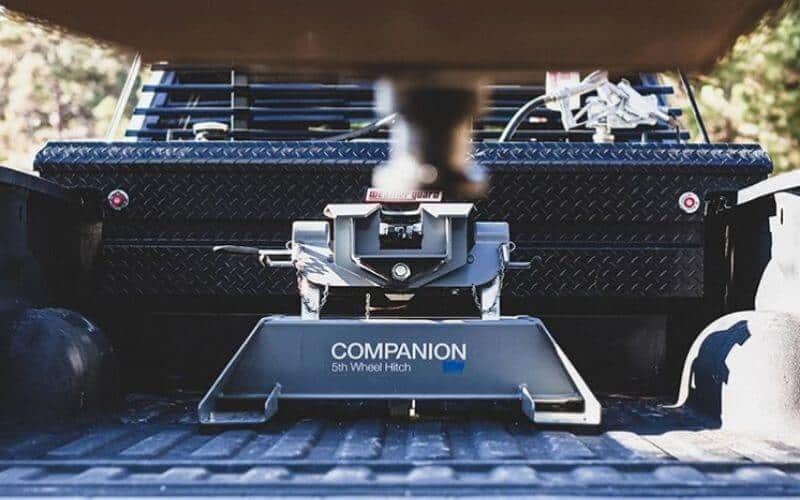One of the best parts about camping is cooking over charcoal or an open fire.
But if you do most of your traveling in an RV, you might not always have a perfect fire pit that allows you to cook your favorite camping foods.
That’s why you should always carry the portable grill for RV camping.
From our experience, it’s a lot more fun to cook outside than to climb into a hot RV a few hours before dinnertime to crank up the stove and/or oven.
Portable grills give you the ability to cook outside wherever you decide to park your RV.
They’re compact enough to easily store underneath your rig and it’s not difficult to obtain the proper fuel to keep your grill lit.
Whether you prefer a portable grill that’s made for charcoal, propane gas, or an open wood fire, there are plenty of options out there.
But evaluating the quality of their components, heat output rating, and other critical factors can require hours of research that you don’t have.
That’s precisely why we’ve canvassed the market to bring you the best portable grill for RV camping.
We’ve also highlighted the most critical factors to selecting a grill that suits your needs in our comprehensive Buying Guide and provided an FAQ section to address any lingering questions.
So let’s dive into our reviews of the best portable grill for RV use!
The 8 Best Portable Grills For RV in 2024
When evaluating the best portable grill for RV camping, we considered size, fuel source, safety, and a host of additional factors.
For each grill we picked, we’ll also share several pros and cons so that you can quickly identify whether or not it fits your demands.
Here are our top 8 picks for the best portable RV grills for your outdoor living or trips:
1. Best Overall: Camco Olympian 5500 RV Mounting gas Grill
Our choice for the best overall portable grill for RV use is the Camco Olympian 55500 because it’s super versatile and includes a number of features that making cooking (and cleaning) much easier.
For starters, it comes with both folding legs and mounting brackets so that you have plenty of options for setting it up in your desired fashion.
I personally love the folding legs because it means you’ll be able to use it in almost any RV camping scenario imaginable.
And if you live in your RV for long periods of time without moving it, you can even mount this grill to the outside of your rig for a more permanent grilling solution.
And speaking of permanently mounting it, this grill can also be connected directly to the low-pressure propane supply that’s built into your RV.
But if you don’t want to go through that hassle, it works with one-pound, five-pound, or 20-pound portable propane cylinders too.
This grill is a single-burner design with a total cooking area of 180 square inches.
It’s rated to a total of 12,000 BTUs and sparks with a Piezoelectric spark starter that’s rated for up to 20,000 starts before it needs to be replaced.
For perspective, even if you used it twice a day every day of the year (which you won’t!), this starter will last up to 27 years!
The total dimensions of this grill are 14.25” x 25.5” x 17.5” and it weighs 26.1 pounds.
It features primarily stainless steel construction but does include a cast iron smoker plate that’s great for exceptional flavor while minimizing grease fires.
And speaking of safety, it also comes with an integrated shut-off valve to prevent accidental fuel discharge.
Things We Like
Things We Don’t Like
2. Easy Care and Maintenance: Weber 51010001 Liquid Propane Grill For RV
If you’re searching for a portable gas grill for rv that’s going to be easy to maintain over its lifetime, the Weber Q1200 is an excellent choice.
The cast aluminum shroud box over the top of the grill area is easy to wipe clean and the cast iron grates can be scraped clean with a standard wire grill brush after every use.
This portable propane grill features a single-burner design with an 8500 BTU rating and a cooking surface of 189 square inches.
That translates to roughly 45 BTUs per square inch. The cooking surface itself is porcelain-enameled cast iron, which provides better flavor than stainless steel or aluminum grates, even if it is a little more susceptible to rust.
This simply means you’ll have to do a better job scraping and cleaning the grates after each use if you want to maximize the lifespan of this grill.
With the lid closed and the tables on either side of the grill folded out, its dimensions are 15.5” x 40.9” x 16.5”, but it collapses to smaller dimensions with the tables folded in when you need to store it.
Those side tables are great for keeping grilling utensils close at hand while using this grill and it means you won’t have to set them on the table you’re cooking on.
And speaking of that, this is a tabletop grill that has long enough legs to allow for safe use on wooden or metal tables.
This grill works with either 14.1-ounce or 16.4-ounce liquid propane cylinders and it uses electronic ignition to start.
The valve setting on the right side of the grill allows you to adjust the heat of the single burner to your desired level and the entire cook box is designed to promote better heat circulation for more even cooking.
Things We Like
Things We Don’t Like
3. Largest Grilling Area: Coleman RoadTrip 285 portable RV propane grill
For those of you that are simply looking for a portable RV grill with the largest grilling area possible, the Coleman RoadTrip 285 is the clear-cut winner on this front.
But because it’s also rated for up to 20,000 BTUs, it’s also one of the most powerful grills on our list.
With a total grilling area of 285 square inches, this grill boasts a cooking output of roughly 70 BTUs per square inch.
And it also allows for better temperature control than many of the other models on our list because it has a three-burner design.
Each burner (left, right, and center) has its own adjustment valve that allows you to dial heat in separately.
This grill also comes with X-shaped collapsible legs so you can set it up easily at any campsite.
You don’t need an existing table to set it on and the wheels allow you to move it easily whether the legs are folded out or collapsed.
The lid of this grill includes an integrated thermometer that gives you the ability to more closely monitor internal temperature for recipes that require a bit more temperature sensitivity.
And although this grill is only compatible with 16.4-ounce liquid propane cylinders, it does include removable cooking grates that are much easier to clean than permanent ones.
The total dimensions of this grill are 30.2” x 19.2” x 16.1” and it weighs approximately 47 pounds.
Unlike many of these portable grills, this one does give you the option to store it upright, which can be useful for smaller RVs or if you need to store it inside the main living area when in transit rather than sliding it into one of your underneath compartments.
Things We Like
Things We Don’t Like
4. Best Budget-Friendly: Flame King RV Mounted Motorhome Gas Grill
If you’re looking for a portable grill for RV use that fits a smaller budget, look no further than the Flame King RV Gas Grill.
But because it’s primarily designed to hook up to your RV’s self-contained LP gas system, this grill is also made for RVers that more permanently live in one location or don’t move around all that often.
It comes with a mounting bracket that allows you to secure the grill right to the side of your RV or trailer.
But that mounting bracket (and the accompanying hardware) can also be used as legs to keep this grill off the ground but make it easier to quickly set up and breakdown if desire more portability.
The grill itself boasts a cooking area of 214 square inches and it features a single-burner design.
It also has an upper grill deck that further increases the total amount of cooking space inside.
The valve at the front of the grill allows you to control the heat level of that single burner and an electric ignition provides reliable starting in most weather conditions.
This Flame King grill is rated up to 12,000 BTUs, which provides a rough total cooking output of 56.07 BTUs per square inch of cooking surface.
The lid on top of the grill keeps heat in if you’re slow cooking and it also locks into place for added security.
This also keeps the grill and all of its components contained while you’re in transit.
The dimensions of this grill are 17” x 20” x 8” without the legs installed and 17” x 20” x 21.5” with the legs.
It’s also super lightweight at 22 pounds. While you can hook this grill up to a standard liquid propane cylinder, you’ll need to purchase the Flame King 96” Quick Connect Regulator Hose separately.
And even to hook it up to your RV’s onboard gas system, you’ll need the Flame King 48” Quick Connect Hose Regulator, which is also sold separately.
Things We Like
Things We Don’t Like
5. Best Charcoal Grill: Gourmia GBQ330 Charcoal Electric BBQ Camper Grill
If you love cooking over charcoal but hate the mess and clean up it comes with, the Gourmia GBQ330 is the perfect solution for you.
With this compact charcoal grill, you’ll be able to give your food that smoky flavor without having to deal with the extra hassle that most traditional charcoal grills require.
This compact design features an 11.8-inch cooking surface that can also double as a stovetop if you place a pot on top.
The cooking grate and drip tray are both removable to facilitate easier clean-ups when you’re done cooking.
And the entire grill set up weighs just eight pounds without charcoal inside.
To set it up, you’ll simply need to fill the small charcoal box with briquets, pour a little bit of lighter fluid into the ignition plate, and light it.
From there, an integrated fan that runs on AA batteries will help you regulate the temperature of the cooking grates for more cooking control than you’ll get with most other charcoal grills.
This grill also comes with lifting tongs that help you safely grab and remove its different components when you’re done cooking.
This allows everything to begin cooling down while you’re eating and speeds up the cleaning process at the end of your meal.
And it also makes this charcoal grill a more portable solution than many others that require you to wait 24 to 48 hours for charcoals to cool before you can clean and store them.
Things We Like
Things We Don’t Like
6. Best Durability: Char-Broil Grill2Go TRU-Infrared Propane Gas Grill
Those interested in making a grill investment that’s going to last should seriously consider the CharBroil Grill2Go X200.
This design features a full cast aluminum firebox that comes with two stainless steel latches for added security.
The entire frame is built to handle high impacts so you don’t have to worry if you accidentally drop this grill while unloading it from your RV.
This grill is designed to use one-pound liquid propane cylinders and features a unique TRU-infrared cooking system that provides greater temperature control and more even cooking over the entire surface of the grill.
And speaking of that surface, this grill has a total cooking area of 200 square inches.
With a maximum heat rating of 9500 BTUs, this grill supplies a total output of roughly 47.5 BTUs per square inch.
While this is a bit lower than some of the other grills on our list, you should also factor in the quality of the cast aluminum firebox when it comes to this grill’s ability to retain heat and cook food evenly.
The handles on either side of the grill also make it super easy to transport and it’s relatively lightweight at a total of just 24.71 pounds.
When assembled, the dimensions of the Grill2Go are 16” x 23.5” x 13.75”.
Both the grate and burner on this grill are manufactured with stainless steel, which also lends to its exceptional durability.
Things We Like
Things We Don’t Like
7. Best with Two Burners: Giantex Propane 20000 BTU Tabletop Gas Grill
If you already know you want a portable grill for RV cooking that has at least two burners, we recommend the Giantex Propane Tabletop Gas Grill.
And because of this grill’s beautiful stainless steel design, you’re also more likely to turn some heads at the campground when you have it set up on the picnic table outside of your RV.
This grill is designed for tabletop use and it has four legs that keep it up off the table for safer use.
But when you need to transport this grill, the legs fold in and the lid locks in place for more compact and secure storage.
And speaking of storage, the overall dimensions of this grill are 22” x 18” x 15” and it weighs just 26 pounds.
The total cooking surface on this grill is roughly 266.5 square inches and each of the two burners is rated for a maximum output of 10,000 BTUs (that means 20,000 BTUs total because of the two burners!).
Each burner has its separate push-and-turn ignition knob that also allows you to control the temperature of each burner individually.
The stainless steel design of this grill also makes it super easy to scrape clean and wipe down after each use.
And the integrated thermometer in the lid provides easier temperature monitoring for any of your recipes that come with greater heat sensitivity.
Things We Like
Things We Don’t Like
8. Most Compact: Cuisinart CGG-750 Venture Gas Grill
The Cuisinart CGG-750 is the most compact portably grill on our list, which makes it a great choice for van lifers or those living in smaller rigs that don’t have as much underneath storage space.
The cooking area on this compact grill is a total of 154 square inches and it boasts a maximum BTU rating of 9.000 units.
This provides a rough cooking output of 58.44 BTUs per square inch, which is slightly lower than some of the other grills on our list.
You should also note that it doesn’t include a lid or shroud box, so it might take longer to cook some foods on this grill.
You’ll need a one-pound liquid propane cylinder to provide fuel for this grill and that tank gets inserted into the hose fitting underneath the cooking grate and within the base of the grill.
The benefit of this design is that the propane cylinder can be disconnected and stored upright in a flip-out rack within the base of the grill when not in use.
The entire base and cooking grate on this grill feature stainless steel construction.
This makes it very durable and means the cooking grate provides good heat transfer and conduction. The lid, however, is made of wood.
This design element actually makes the entire grill look something like a picnic basket when in transit.
And a picnic-like situation is exactly what this portable grill is designed for.
That wooden lid doubles as a cutting board when you reach your destination and small legs on the bottom of the grill allow you to set it up on the ground or a picnic table with ease.
Things We Like
Things We Don’t Like
How Did We Pick The Best RV Grills?
Now that you’ve browsed through what we liked and didn’t like about the top portable grills for RV use, it’s time to get a better understanding of what separates them.
In this Buying Guide, we’ll cover the important specifications and features of these grills so that you can more accurately compare them.
Ultimately, you’ll need to evaluate these factors in order to choose the best grill for your specific needs. So let’s get into it!
Types Of Portable Grills
We can break portable grills into two categories. There are those designed for use with charcoal briquets and others that you plug a small propane cylinder into.
Let’s start by discussing the pros and cons of these two types of grills.
Portable Propane Grills
Propane grills can come with a higher up-front cost, but they do save RVers money over the long term.
They also tend to be less messy and easier to clean than their charcoal counterparts.
They can often be scraped and the scraps dumped out without worrying about residue accumulating in the bottom of the grill.
But these grills do require that you always have a sufficient number of propane cylinders on hand to meet your grilling needs.
Depending on where you travel and camp, refilling or replacing these cylinders can sometimes be challenging.
And because these grills rely on gas, they tend to have more complicated mechanics that can sometimes break or malfunction.
Portable Charcoal Grills
Many RVers opt for charcoal grills simply because they like the unique smoky flavor that charcoal gives their food.
Charcoals are actually reasonably affordable and easy enough to obtain if you plan your RV adventure in advance.
Charcoal grills are also super lightweight and they tend to have fewer mechanical components than their propane brothers.
This means they are less likely to break, leak or malfunction when you need them most.
Perhaps the only downside of charcoal grills is that they require more effort to clean and charcoals take a lot longer to cool down than a gas grill.
Dimensions
In terms of size, you’ll want to consider the grilling area of the grills you’re interested in.
If you’re the kind of RVer who loves to barbecue a full rack of ribs at the campsite, you’ll obviously need a larger grilling area than the casual camper who just wants to be able to throw a few burgers on.
But aside from the size of the grilling area, you’ll also need to look at the total dimensions of the entire grill.
This will give you an idea of whether or not you’ll be able to store it underneath your RV without taking up too much space.
During this process, you’ll also want to analyze the size of your underneath compartments (and how full they already are!).
Of course, you can also decide to store your portable grill in another location on (or attached to) your RV.
But the main idea here is that you should make sure the portable grill you choose is small enough to fit comfortably wherever you intend to store it when it’s not in use.
Legs Or No Legs?
Some of these portable grills come with legs that will allow you to set them up at roughly waist height.
This will provide a similar experience to what you’re used to with your traditional at-home barbecue grill.
But not all models come with legs, so you’ll need to decide how important this feature is to you.
Other models that don’t have legs are designed for tabletop use. And a quality tabletop grill should have some sort of insulated feet so that you can place them on plastic, metal, or wooden tables without worrying about the heat from the grill causing damage to the table.
However, this isn’t always the case. Sometimes you’ll need to place an additional layer of insulation between your grill and the table.
And if you don’t often have a table at the places where you like to camp, then you’ll have even more reason to choose a portable grill with extendable legs.
How long do you expect your grill to last?
The materials used in the construction of a specific portable grill are going to dictate its durability.
You’ll find grills manufactured with stainless steel, aluminum, cast iron, ceramic, and a variety of other materials.
In terms of maintenance, stainless steel requires the least care and attention over the life of a portable grill.
It’s also rust-resistant and easier to clean than aluminum, ceramic, or cast iron. But the downside of stainless steel is that it tends to be heavier than some other grill materials.
This is where you can start to consider how easy a certain grill will be to move around and set up in different locations.
A stainless steel grill will certainly require less maintenance, but it will also be heavier and harder to move around.
So if portability is more important to you than ease of cleaning, you might be better off with an aluminum grill.
And aluminum grills also have the advantage of being resistant to rust and corrosion over the lifespan of the grill.
In terms of your other options, some of the most compact grills out there are constructed with ceramic material, which does a good job with heat retention if you’re into slow cooking.
But ceramic grills also tend to be heavy and more likely to crack or break if they aren’t handled carefully.
And the other main material that you may find used in portable grills for RV living is cast iron.
While this material does certainly add to the overall weight of a grill, many RVers prefer it because it can simply be scraped clean after each use.
With some cast iron grills, however, you’ll need to add a small amount of oil to the grill regularly in order to keep it from rusting.
Controls and Features
Temperature control is a super important component to consider when choosing a portable grill.
Different foods require higher or lower temperatures, so the ability to make adjustments depending on what you’re cooking is super critical.
But the style of controls is also just as important as making sure the grill simply has controls.
Unless you’re really experienced with complex grill systems, you’ll want something with simple dial-style controls that allow you to adjust the heat with a turn of the knob.
Most of the best portable grills for RV cooking provide single controls that are very user-friendly.
But if you desire more control, you’ll want to look for a grill that offers dual controls so that you can set different temperatures on different sides of the grill so that you can cook vegetables at a different temperature than your meats.
Additionally, these grills come with a host of features that may be more or less important to some buyers than others.
The exact features you’ll want largely depends on how you like to cook and your preferences for moving and storing the grill.
Combing through user reviews on specific grills is also a great way to get more information about how certain features actually operate in a real-life cooking scenario.
Features like mounting capability, collapsible legs, and others will obviously be more important to some of you than they will be to others.
But for our money, having a grill with legs is one of those features we would almost always prefer.
This is simply because we don’t always park our RV in places that have tables where we can set up a grill without legs.
And we just don’t prefer to sit cross-legged on the ground or bending over when tending to our grill.
Numer Of Burners
Because of their size, most of these portable grills either have one or two burners.
If you tend to cook only one type of food on your grill at a time, a single-burner design will probably do just fine for you.
But if you like to grill a little more complicated meals, you’ll want a dual-burner design that gives you more temperature control.
But you’ll also need to look at the construction of the burners themselves. While this, of course, only applies to propane grills, the best two materials used in burner construction are stainless steel and brass.
These materials are both corrosion-resistant, which is not the case with other materials.
There are also grills with burners made of aluminum and cast iron. But these materials come with larger downsides than stainless steel or brass.
Aluminum burners can have a higher tendency to burn out prematurely and cast iron burners are more susceptible to rust over time.
Types Of Grill Grates
In addition to considering the design and number of burners, you should also compare grate construction across several grill models.
Common grate materials include stainless steel, enameled porcelain, aluminum, and others.
The material used in the grates on a grill will play a role in how foods cook on them and also how easy (or difficult) they are to clean.
Before you even consider the material, however, we recommend prioritizing a grill that has removable grates.
While this is pretty common to the best portable grills for RV use, grills without removable grills are much more difficult to clean and service than those that allow you to remove the grates as needed.
Generally speaking, cast iron grates are great for heat transfer and conduction, but the downside of cast iron is that it’s more susceptible to rust.
Therefore, it requires more regular cleaning and maintenance to ensure a clean cooking surface.
Aluminum grates are common on the most lightweight portable grills, but they don’t offer nearly the heat transfer that you’ll get with a cast iron or stainless steel grate.
And while an aluminum grate will be relatively easy to clean, it won’t be nearly as durable as stainless steel or cast iron.
But if we were shopping for a new portable grill for RV living, we’d opt for a grill with stainless steel grates.
Stainless steel offers better heat transfer and conduction than aluminum and it’s not as susceptible to rust like cast iron.
Additionally, stainless steel is lighter than cast iron, so it tends to provide a happy medium of both performance and portability.
What price range are you looking in?
Most of the best portably grill options on our list come with triple-digit price tags. The most budget-friendly options, however, are available for less than $100.
That being said, you can expect to spend somewhere between $150 and $300 if you want to get a high-quality portable grill for RV camping.
So, Which Is the best RV Grill?
The Camco Olympian 5500 is our choice for the best overall portable grill for RV living because of its versatility.
It has folding legs that allow you to set it up easily in any camping situation and it can also be more permanently mounted to the side of your RV if you live in your rig full-time without moving around frequently.
But we also love the Coleman RoadTrip 285 for its extra-large grill size.
If you like to camp with large groups or your extended family, you’ll want the extra grilling area to make sure everyone’s burgers come out at the same time.
And with this grill, you’ll also get easy portability and more temperature control than most other portable grills.
Frequently Asked Questions
There are a few things we still haven’t addressed regarding the best portable grill for RV camping.
So let’s take a few more moments before you leave to address the most frequently asked questions about these grills and their operation.
What are BTUs and how do the impact the performance of my grill?
The term BTU stands for ‘British Thermal Units’. It’s a measurement of how much heat a grill can produce, but it will also tell you how much fuel you can expect a given grill to consume.
In general, grills with a higher BTU rating will consume more fuel over the lifetime of the grill.
While it can be tempting to simply look at overall BTU ratings when comparing grills, a more constructive method is to divide a grill’s BTU rating by its total cooking area.
For example, a grill with a 12,000 BTU rating and a cooking surface of 180 square inches will produce an output of roughly 66.67 BTUs per square inch.
For comparison’s sake, we can look at another grill that’s rated up to 20,000 BTUs. For our example, we’ll say that this grill has a super large cooking area of 350 square inches.
By dividing BTUs by total cooking area, we can see that this second grill provides an output of roughly 57.14 BTUs per square inch.
The point of these two calculations is to illustrate that you should look deeper than simply comparing overall BTU ratings when considering two different grills.
Upfront, a grill rated for 20,000 BTUs looks more powerful than the one rated for 12,000 BTUs, but in practice, you’ll actually get more heat output per square inch with the smaller grill in this scenario.
Honestly though, both of these numbers are a little lower than what we’d recommend looking for from a portable grill.
As you’re comparing different models, look for ones that offer somewhere between 80 and 100 BTUs per square inch of cooking surface.
What differences are there between grills for RV use a regular backyard grill?
In terms of operation, they function in much the same way. If we’re talking propane grills, they both will need a bottle or tank filled with liquid propane to use as a fuel source.
But grills made for RV use work with much smaller propane tanks than your typical backyard grill.
Also, these portable grills are much smaller and compact than a regular backyard grill.
This is what allows them to fit in the underneath compartments of your RV, but it also means that many of these grills need to be set on a table if you want to grill at a comfortable height.
Some, however, do come with collapsible legs that make it easier to set them up on a wider variety of surfaces.
If you do get a tabletop propane grill, just make sure to protect the table from the heat of the grill using a small sheet of metal or even aluminum foil.
How do I clean my portable grill after each use?
The best way to maximize the longevity of your portable grill is to clean it thoroughly after each use.
For starters, you should actually turn up the heat for 2-5 minutes after taking your food of the grill to cook off any oils or food scraps that have dripped on the grates during the cooking process.
Of course, “turning up” the heat won’t be possible if you have a charcoal grill, but the heat of the charcoals will essentially have the same impact as they stay hot after you take your food off the grill.
Once you’ve turned off your grill and it has cooled down (or your charcoals have sufficiently cooled), you should use a grill brush to scrape off any remaining residue that has now sufficiently burnt onto the grates.
If you have a charcoal grill, you’ll have to remove the grates and dispose of your charcoals properly.
Always make sure they’re thoroughly cooled and check with the campground (or your local municipality) for proper charcoal disposal practices.
This might be all you need to do if you’re on-the-go and don’t have further means to deep clean your grill.
But once you get home, you can also remove the grates on your grill and place them in a self-cleaning oven. This is a good way to remove any additional residue that’s leftover.
What if my propane grill isn’t heating up?
There could be many different culprits responsible for a propane grill not heating up.
The most common problem, however, is a propane leak somewhere in your system.
Most modern propane grills come with a safety feature that will automatically drop the if it detects the possibility of a leak. By dropping the gas pressure, your grill will produce a much smaller flame.
Therefore, it will likely take longer to heat up than usual (or it simply won’t heat up at all!).
Using soapy water in a spray bottle, you can check all of your lines (while the flame is out) to check for a leak.
If you can’t find any places where the soapy water is bubbling up and signaling a leak, it’s possible that the built-in safety feature could be receiving a false reading.
If you think this is the case, you can reset the values on the safety feature and your grill should be heating up as normal again.
Do you have any safety tips for these grills?
Yes! But we think it’s best to address the two types of grills separately when answering this question. So we’ll start with safety tips for propane grills.
Best Practices for Propane Grills
Perhaps the easiest way to give you some best practices is in the form of a bulleted list:
-
Always use your grill outside in a well-ventilated area. If you place it on a wooden table, make sure there’s a layer of insulation between the table and the grill.
-
Always shut off gas controls and close the valve on the propane cylinder when you’re done grilling.
-
Allow the grill to cool down before cleaning or moving it.
-
Always store propane cylinders in an upright position and make sure they’re away from any heat or potential ignition source.
-
When storing the grill, cover hose fittings and burner air intakes with appropriate protective fitting caps. If you can’t find the right caps, use small plastic bags to make sure dirt, insects, moisture, or anything else foreign doesn’t enter.
-
Always test your gas fittings for leaks before igniting burners.
Common Propane Grill Mistakes
And here are some things to avoid when using a propane grill:
-
Avoid smoking while grilling or handling propane cylinders.
-
Never leave propane cylinders in a hot vehicle for long periods of time.
-
Never operate a grill with a propane cylinder in an enclosed space.
-
Don’t store propane cylinders in a closed space that’s subject to extreme heat.
-
Keep children away from your grill while it’s in use until they’ve been educated on how to safely use and operate the grill.
Best Practices for Charcoal Grills
Now we’ll cover the best practices for charcoal grills:
-
Ensure lighter fluid has sufficiently soaked into charcoal before lighting.
-
Form a pyramid of charcoal at the center of your grill for maximum lighting effectiveness.
-
Cap lighter fluid immediately after use and place it at a safe distance from the grill (and out of reach of children).
-
Always keep the grill vent open while cooking.
-
Allow plenty of time (24 to 48 hours) for the coals to cool before disposing of them.
Common Charcoal Grill Mistakes
Avoid these common mistakes if you decide to purchase a charcoal grill:
-
Never use gasoline, kerosene, or any other highly combustible fuel source to light charcoals.
-
Avoid adding more lighter fluid to coals that are already warm or hot.
-
Never touch coals with your hands to test if they’re hot.
-
Never use an additional starter if you’re cooking with instant light charcoal.
Conclusion
If you’ve done any extended RV camping, you already know that the conditions every evening aren’t ALWAYS favorable for cooking over a campfire.
If they aren’t, it can put a serious damper on your dinner plans. But that will never be the case if you have a portable grill at your disposal.
Whether you use it as a backup to cooking over a campfire or you prefer it all the time (because it’s a safer option!), a portable grill is a great addition to your RV camping equipment.
We hope you’ve learned something new about these grills in this article and we want to hear about your experience with the grill you eventually choose! Leave us a comment below and share your feedback about your final choice for the best portable grill for RV living!

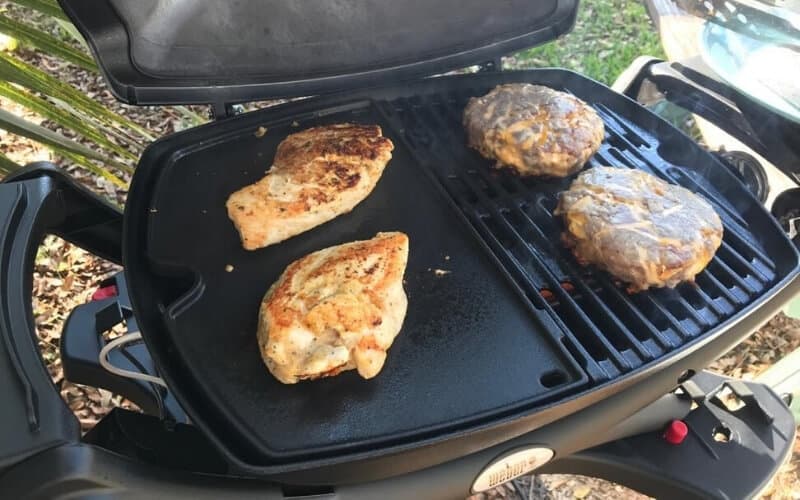
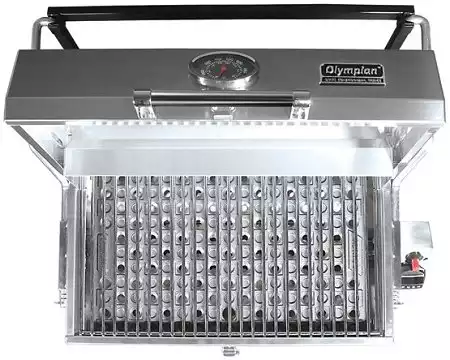
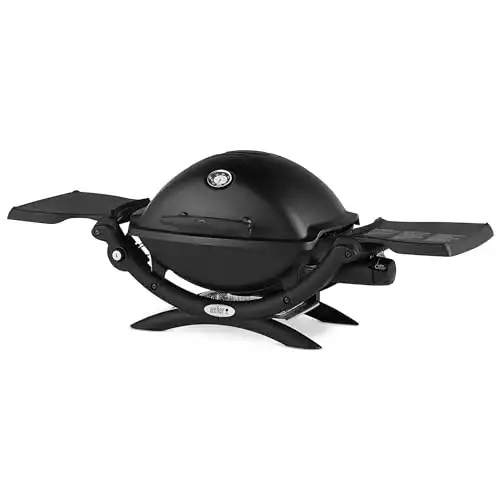
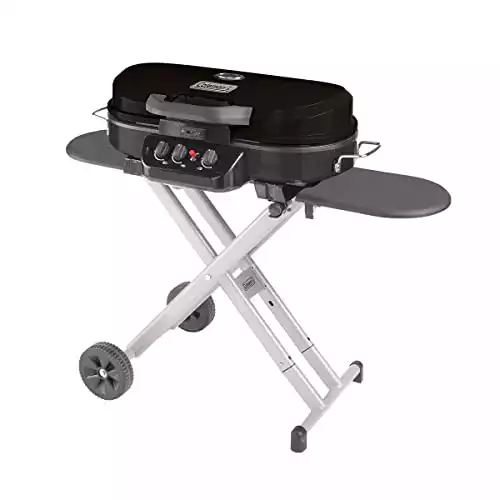
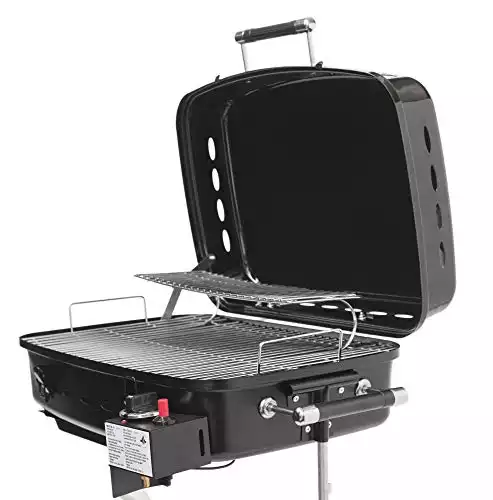
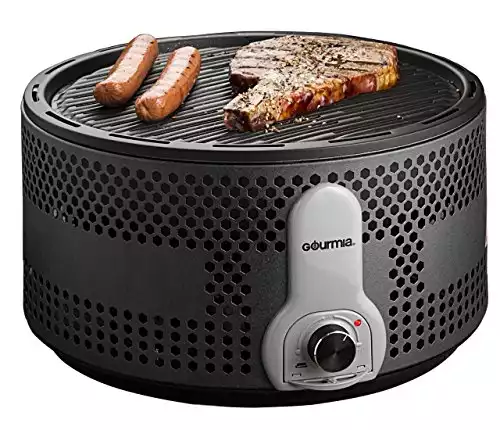
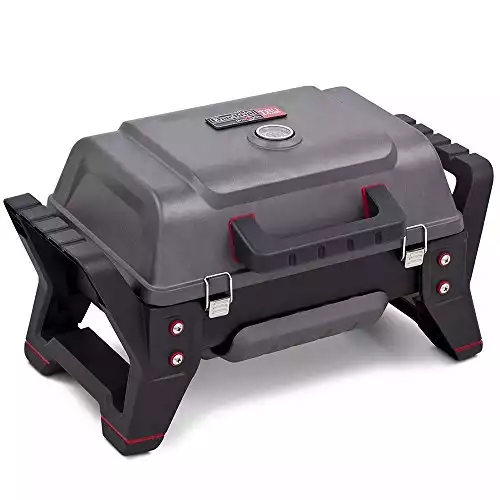
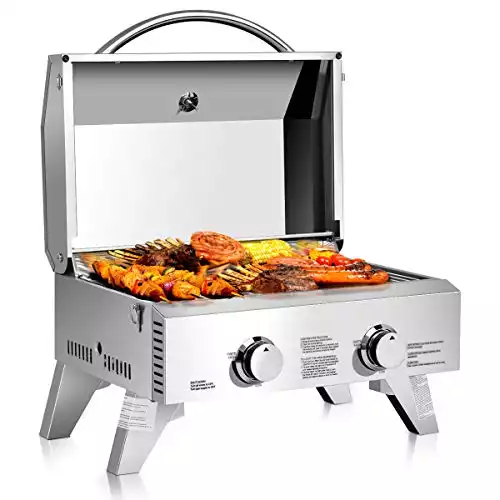
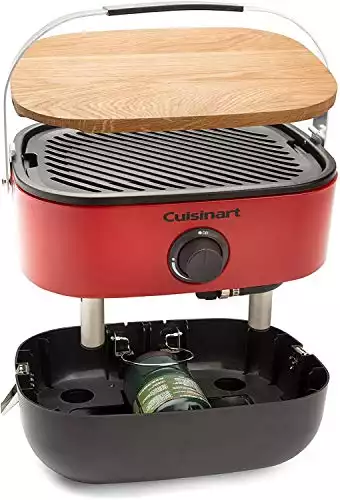

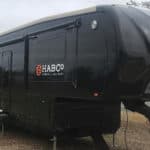
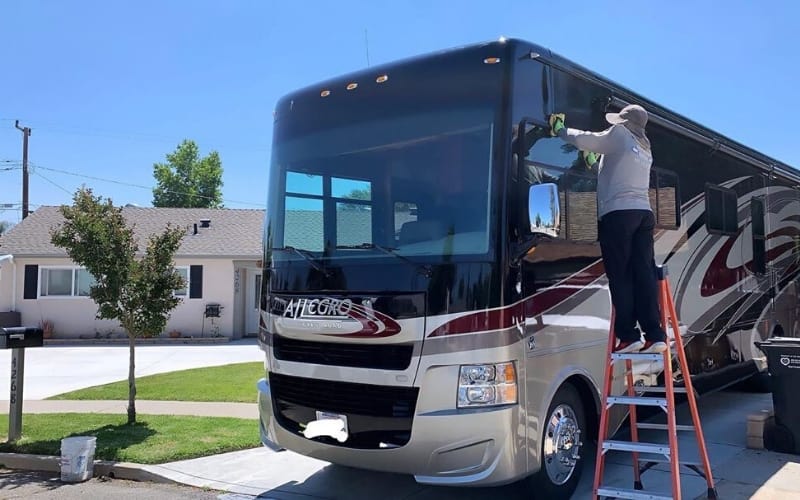
![Our Review of The 8 Best RV Vacuums in [currentyear] and Why 13 Best RV Vacuum](https://www.rvingknowhow.com/wp-content/uploads/2020/06/Best-RV-Vacuum.jpg)
